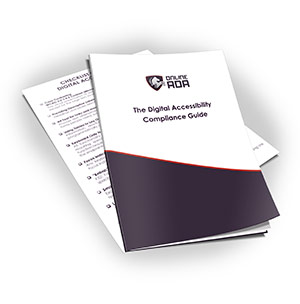The Web Content Accessibility Guidelines (WCAG) are the go-to standard for digital accessibility around the world. As a set of technical guidelines that developers, coders, and website designers can reference in order to create an accessible website (or remediate an older, inaccessible website), they offer specific criteria for various types of digital content to meet.
However, the technical explanations and jargon included in WCAG can seem a little intimidating at first. Understanding some WCAG basics will help introduce you to the guidelines and explain what you should incorporate into your website’s digital accessibility.
So what should you know about WCAG if you’re new to digital accessibility?
Here are 7 quick facts and corresponding explanations to break down the guidelines, how they work, and their current conformance levels:
1. The current version of WCAG is version 2.1.
- As the newest version, 2.1 is the standard that the W3C — the international community that created WCAG — recommends businesses should conform to.
2. However, some accessibility laws around the world currently cite conformance with WCAG 2.0, not 2.1.
- This is typically due to the amount of time it takes to update a law. Since the W3C releases updates to WCAG every few years or so, it can take time to see those updates incorporated. Luckily, version 2.0 and 2.1 are similar and have the same general organization; version 2.1 simply builds upon 2.0 and includes 17 more criteria to meet. Fully satisfying version 2.1 means you automatically satisfy version 2.0.
3. WCAG is made up of guidelines called success criteria that are organized into one of four categories, depending on how that individual criterion applies to accessibility.
- WCAG states that all websites and digital content must be perceivable, operable, understandable, and robust (POUR). These four principles of accessible design are also the main categories that organize WCAG, and each success criterion falls under a specific category.
4. Both WCAG 2.0 and 2.1 also assign success criteria a level of conformance: Level A, AA, or AAA.
- A success criterion’s conformance level is determined based on how essential an issue it is to fix. At the lowest level, Level A conformance is considered essential for offering an absolute minimum level of accessibility and providing basic access to web users. Without meeting Level A requirements, some users will not be able to navigate or use a website at all.
- Level AA incorporates more success criteria to build upon that accessibility even further. Meeting Level AA will resolve accessibility issues that offer minimal access to digital content or cause significant frustration for users with disabilities.
- Level AAA includes accessibility solutions that provide an even more enhanced accessible experience for many users with disabilities. While meeting Level AAA doesn’t necessarily mean that a website is perfectly, 100% accessible, it can offer a high level of support.
5. Level AA is typically the conformance level that most businesses are either legally required or recommended to meet.
- Again, this comes down to your country’s individual law. If the law specifies WCAG conformance, it will typically state whether the accepted level is Level A or Level AA. While achieving Level AAA conformance results in high levels of accessibility, it actually isn’t possible for a single site to conform to all Level AAA success criteria because some of them cancel out others!
6. Partial conformance with any WCAG version or level does not guarantee a business is completely safe from litigation.
- Partial conformance is much better than not conforming at all, but full conformance is the only way to protect your business from litigation. More importantly, it’s the only way to ensure you’re giving web users an accessible experience.
7. New updates to WCAG are in the works.
- Version 2.2 is set to release later this year, with a tentative date of October 2021. It will build upon version 2.1 just as 2.1 built upon 2.0, and will follow the same POUR categories and A, AA, and AAA conformance levels.
- WCAG 3.0 is currently in draft, and will incorporate a brand new organizational structure — with Bronze, Silver, and Gold conformance levels. It will have new criteria that aim to be more understandable and easily testable.
By understanding WCAG and incorporating its standards as early as possible, you’ll ensure that your website offers an accessible experience to everyone.
Have questions about how Online ADA can help you with your digital accessibility? Contact us to learn more.


